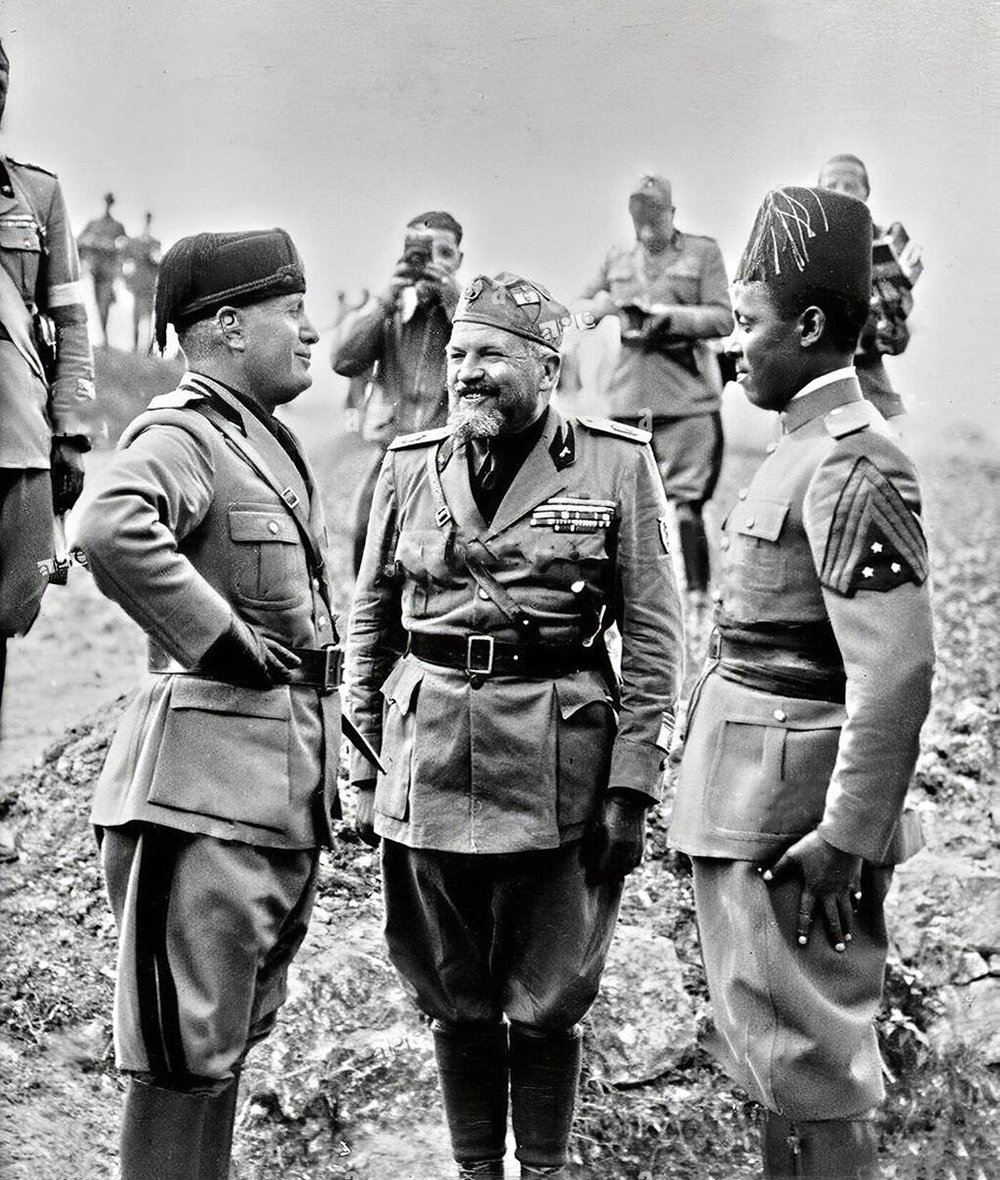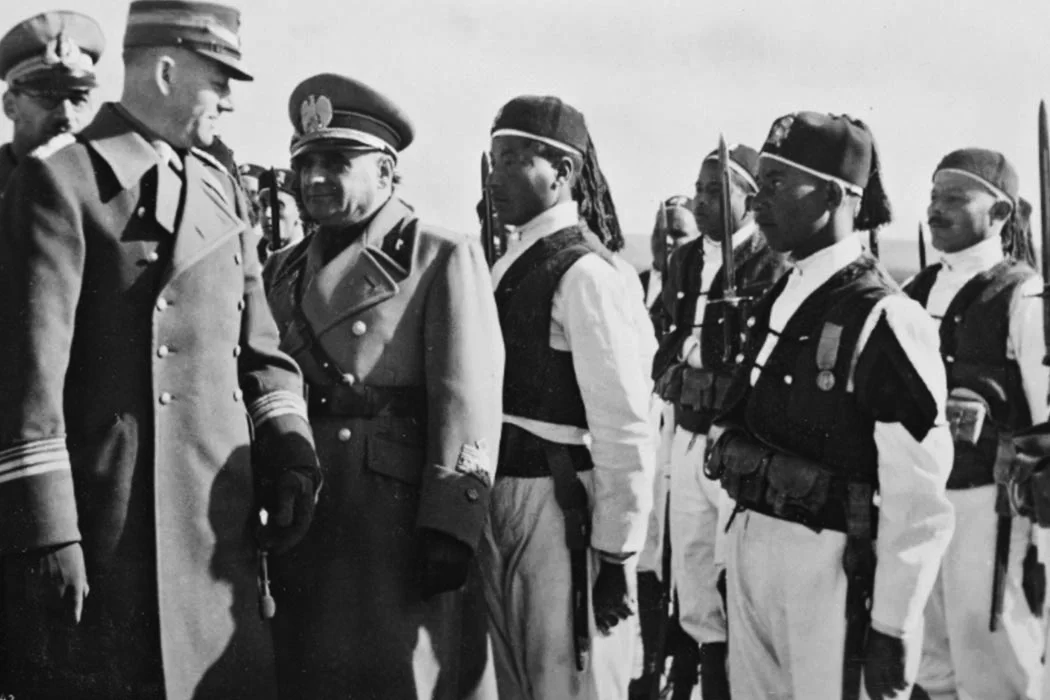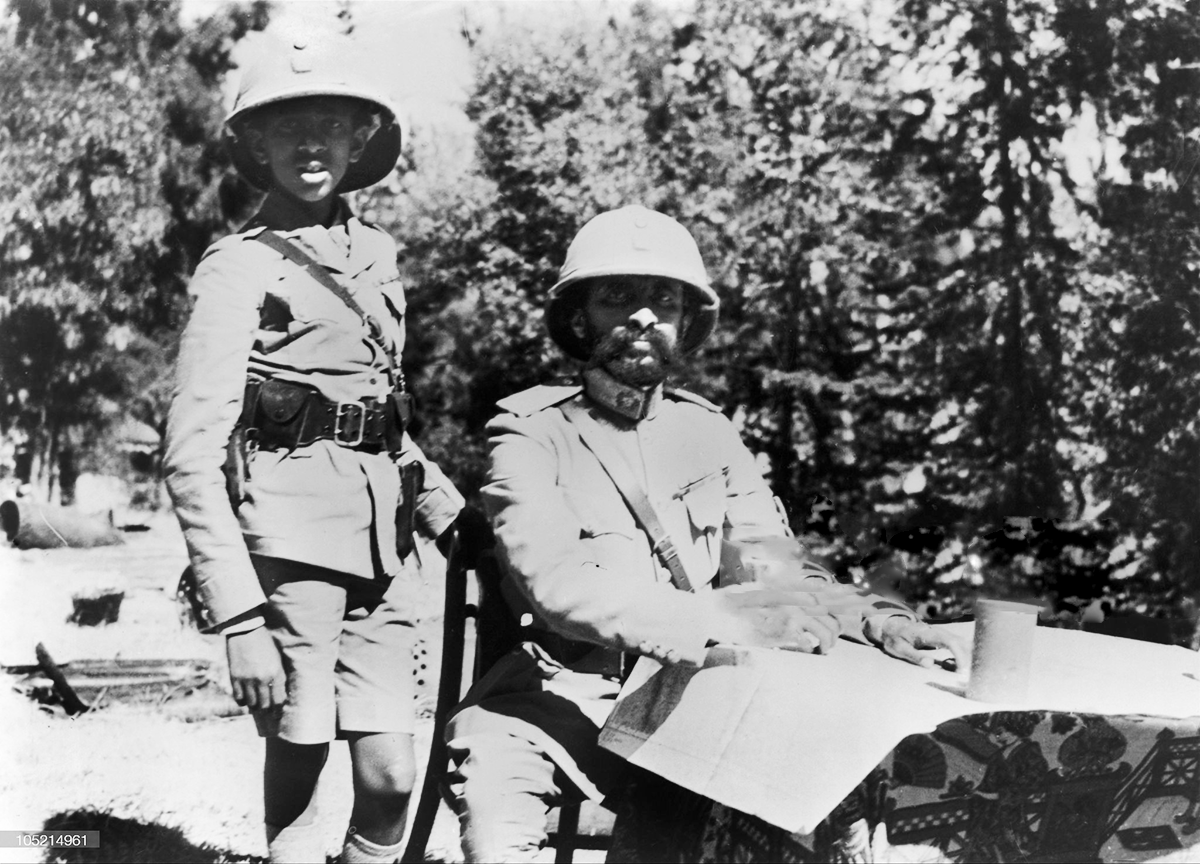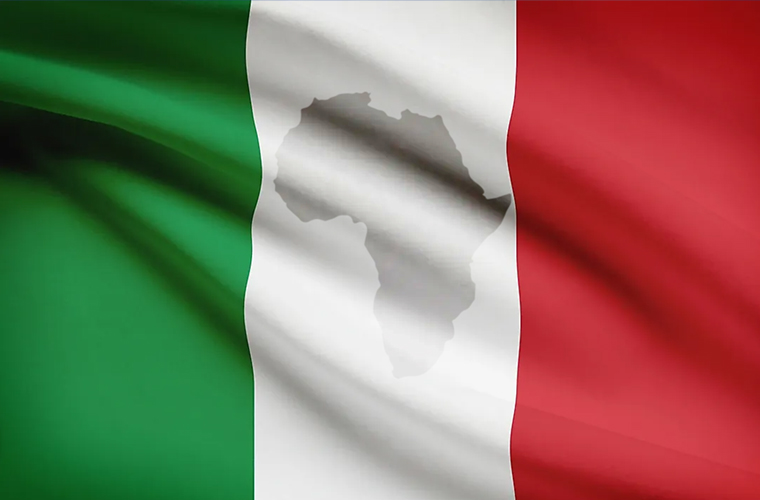Italy was one of the European countries with colonies in Africa during the modern period. Lasting from 1890 to 1941, Italian colonialism in Africa included the present-day countries of Libya, Ethiopia, Eritrea, and Somalia. Italian colonialism in Africa came to an end with the death of the Italian leader Benito Mussolini, the collapse of the Fascist regime, and the defeat of Italy in World War II. Half a century of Italian colonialism had long-term effects on attitudes toward race and racism in both Italy and its colonies.
Italian colonization of Africa took place during the same period as other European colonials in the region. In many respects, Italian colonial policy was similar to that of other colonizing powers. Italian colonial policy differed, however, in that it was premised more on enhancing the glory and overall international prestige of Italy, rather than on the economic benefits that could be gained from colonies. Italian colonialism was also not guided by religious motives of converting native populations to Christianity. Italian imperialism was later shaped by Fascist doctrines of governance and social policy, which affected methods of administration and treatment of the indigenous African population.
Italy’s colonial experience forced Italians to confront the presence of non-Europeans within the Italian Empire. The presence of black Africans, especially, led some Italians to construct racial hierarchies in which Italians and other Europeans stood at the top, Arabs and North Africans somewhere in the middle, and black Africans at the bottom in terms of rights and privileges. Such racial-ist thinking led some Italians to consider the position of Jews within Italy in a parallel manner and to place them on this racial hierarchy. Italian attitudes toward Jews, which had previously been generally benign, began to change as a result of African colonization.

Italian colonization can be divided into two periods. The first begins in 1890, with the Italian colonization of Eritrea, and continues with the acquisition of Libya and Somalia, and the invasion and occupation of Ethiopia. The second period begins around 1937, when the occupation of Ethiopia was complete and when the Fascist racial policy became more explicit and extreme. This article will examine racial policies in the Italian colonies during both periods and will conclude by noting the impact of the colonial experience on post-imperial Italy.
COLONIAL RACISM BEFORE AND DURING THE RISE OF FASCISM
By European standards, Italy is a young country, having become unified as one nation only in 1861. Before that time, what has twenty-first-century Italy consisted of several independent kingdoms. Unification brought Italians together as one people and created a sense of shared national identity—as Italians rather than as Florentines or Neapolitans—including a feeling of common national destiny. Part of this feeling, among some Italians, included a desire to acquire overseas colonies—as other European countries were doing—and to relive the glories of the Roman Empire.
Italy, as a relative latecomer to the colonial project, acquired what many Europeans considered to be the less desirable territories in Africa, including Eritrea, where Italian colonization was established in 1890; Somalia, where Italian rule began in 1905; and Libya, where Italian rule commenced in 1912. Italy had also attempted to invade Ethiopia in 1895 but was repulsed by Ethiopian forces in the Battle of Adwa, a sharp blow to many Italians in that a European army was defeated by an African one. The memory of this defeat would later inspire a second invasion of Ethiopia.
Late-nineteenth-century and early-twentieth-century anthropology were concerned with racial classification. With new colonies in Africa, Italian scholars became interested in how colonial subjects fit into racial classifications. Such classifications grew from work done in the early nineteenth century and were based on the traditional Biblical division of peoples into the Caucasians, Semites, and Hamites, who were the descendants respectively of Japheth, Shem, and Ham, the sons of Noah. In the Bible, the descendants of Ham are cursed and destined to become slaves. An alternative interpretation argued that the descendants of Canaan, one of Ham’s sons, and not the other children of Ham, were cursed.
This interpretation allowed for a separate, fourth race, which was associated with black Africans and was used by Europeans to justify African slavery. It was also used by Europeans to explain how the pyramids and other monuments of Egypt were created—not by black Africans, the descendants of Canaan, but by the Hamites, the descendants of Ham’s other children. Such an interpretation helped form racial attitudes toward black Africans, who were considered inferior and incapable of civilization.
Early twentieth-century anthropologists such as Aldobrandino Mochi and Vincenzo Giuffrida Ruggeri modified traditional European views using what they considered “scientific” methods, such as skull measurements. They nevertheless perpetuated the argument that black Africans were inferior people, but that the peoples of Libya, Eritrea, Ethiopia, and Somalia, being of Semitic background (with some Hamitic or African admixture), were capable of civilization. From this racist perspective, Italy could congratulate itself on acquiring colonies in those parts of Africa where the potential for civilization was greatest. Other anthropologists, such as Giuseppe Sergi, argued that Europeans actually originated in Africa. Thus Italy’s racialist views of its colonial subjects differed in some respects from that of other colonial powers.

Using such arguments, Italy could justify its conquest and subjugation of Africans, with the hope that Italian civilization would spread to the colonized regions. There was general support among the Italian population for imperialism, as it was seen as the “mandate of history” and a continuation of the conquests of the Roman Empire. At the same time, the Roman Catholic Church wanted recognition of its primacy over the Orthodox churches in Egypt and Ethiopia, furthering the attitudes of Italian destiny.
Despite the theoretical respect for peoples of Semitic and Hamitic origin, the actual Italian conquest was brutal. For example, the conquest of Libya—sometimes called the “Fourth Shore” of Italy—was lengthy and oppressive. Italy began its invasion of Libya in 1911 and succeeded in driving out the Turks, who controlled the territory, in 1912. But the Arab Libyans did not see the Italians as liberators; they resisted the Italians until 1932. The resistance movement, the Sanussi, was repressed, and its mosques closed, and its leaders, such as Omar Mukhtar, were imprisoned and executed. More than 100,000 Libyans were imprisoned in concentration camps, and from 1928 on cities were bombed with poison gas (despite Italy being a signatory of the Geneva Convention in 1925), which one Fascist commentator described as a “cleansing.” Separate communities were established for Italians, keeping them apart from Arabs and Jews.
Similar actions took place during the Italian colonization of Somalia and Eritrea. Official Italian rule began in Somalia in 1905. Slavery, which existed in the country, was abolished by the Italians, and the slave trade was outlawed, leading to opposition from some Somali tribes. The Italians looked upon the Somalis as children needing paternal guidance, but they permitted local chiefs to rule, and the Italians were also generally unconcerned about race, permitting some marriages between Italians and Somalis, and tolerating informal sexual relations between the two groups.
In Eritrea, three residential districts were established in the capital, Asmara: one for whites, one for blacks, and one for people of mixed race (indicating that intermarriage was a common practice). In Italy itself, racism was largely absent. People of mixed Italian-Jewish background who did not practice Judaism as a religion were considered to be Italian, and not in a separate category of “Jewish.” Religion was more important than race or national origin. Italians saw themselves as a spiritual community to which Jews could also belong. This was to change, however, with the rise of Benito Mussolini and the Fascist Party, which came to power in 1922.
COLONIAL RACISM UNDER FASCISM
In general, there was not much change in Italian attitudes toward colonialism and imperialism during the transition from pre-Fascist to Fascist Italy. Most Italians supported the idea of empire with moderate enthusiasm but did not hold particularly racist attitudes towards non-Italians. The Fascist Party, however, began implementing new racial policies in Africa, which began to change perceptions of race in Italy itself. The fascist policy emphasized war and conquest, the revitalization of the state, the rejection of tradition and the past, and the forging ahead to a new future that was to be achieved through force. Fascist policy in the colonies introduced legal racism.
Laws banning mixed marriages were introduced in Eritrea in 1933 and in Ethiopia in 1937 (one year after the conquest of that country by Italy in 1936). Fascists thought that mingling Italians with Africans weakened the Italian people. Fascists also considered a problem the children born from mixed marriages, resulting in persons who did not completely fit within either Italian or African culture. As Fascist Party Secretary Achille Starace noted, “With the creation of the Empire, the Italian race came into contact with other races. Hence it had to guard itself against hybridity and contamination.”
In its colonies, Italy began to impose racial separation. Blacks and whites were not allowed to live together, and children of mixed marriages were not considered legitimate. Colonial administrations created separate facilities for Italians and Africans, including separate buses, restaurants, and movie theaters. Some professions were limited to blacks or whites only. Italian and African workers could not work on the same site at the same time. Italians could not serve Africans in shops. Italian taxis could not accept Africans as passengers. Films shown to Africans were censored, lest any sign of weakness is perceived among Italians.
Italian Fascists justified this “apartheid” on the basis that too much concern for native populations smacked of nineteenth-century liberalism, rather than of the New Order created by Fascism. As one colonial engineer stated, “We must ban natives from any access to our cities unless we can force them to pass through a sort of station of human reclamation. In a perfect colonial city, the destruction of bugs and the disinfection of clothing must be carried out in a totalitarian fashion” (Bosworth 2006).
Fascist leaders determined that the party had to take the lead in explaining racism to the public. These policies would not be copied from the Nazis in Germany but would spring from three thousand years of Italian history. In 1938 Mussolini had little interest in the persecution of Jews; he did not have the racial fanaticism of Hitler. Even hardcore Fascists such as Roberto Farinacci disliked Nazi doctrines, especially Alfred Rosenberg’s racist ideas because he believed that ideas about German racial superiority could be used against Mediterranean people as well as Jews. Farinacci and other Italian Fascists disliked Nazi talk of blond, blue-eyed people as superior.

Mussolini’s policy on race in Ethiopia and other Italian colonies was that the native peoples were not to be held in contempt, but there was to be a separation between the races. Italians, including Fascists, generally did not approve of Nazi doctrines, thinking them crude, pagan, brutal, and unprincipled. The Nazis had even suggested that Italians had African blood (Mussolini replied by hinting that Germans had Jewish blood)! The Fascist journal Critica Fascista noted in 1934 that racial doctrines were not fascist, but rather a threat to fascism.
But by 1938 the Fascists established a racial policy that specifically emphasized white superiority. Africans could be punished for not respecting Italians. If an Italian was caught committing a crime by an African policeman, he could not be arrested because that would undermine the prestige of Italians and the white race generally. Indeed, Mussolini claimed that Italy conquered Ethiopia because of Italian superiority and African inferiority (he conveniently forgot about Italy’s defeat by Ethiopia in 1895).
Fascist racial laws were often ignored and not enforced, however, because they seemed alien to both Italians and colonial subjects. A practice known as madamismo—sexual relations between Italian men and African women—was widespread in Italy’s East African colonies. Madamismo resulted from the imbalance between the large number of Italian men working in the colonies, and the relatively small number of Italian women living there (most men left their families home in Italy). Many children with Italian fathers and African mothers were born and were accepted as legitimate until the race laws of 1938 criminalized madamismo and delegitimated children of mixed race. Nevertheless, the practice continued and laws against it were rarely enforced: Around 10,000 children of mixed race were born during the period 1936–1941 in Ethiopia alone.
Laws mandating racial separation were hardly effective. Whites and blacks continued to live side by side, despite segregation orders. Italians and Africans did share taxis, dined together in cafes, and walked together in the street, though laws forbade this. Ethiopian notables were deferred to by Italians and served by Italians in restaurants and bars. Racist laws mandating separation by race were alien to most Italians, and most Italians in the colonies, therefore, ignored them with impunity. Many Italians remembered the brutality of the conquest of Ethiopia in 1935 and were sympathetic to its inhabitants and critical of racist laws and policies. One working-class Italian was quoted as saying that the Fascist regime “would have been better off first to think about civilizing the Italians” before trying to civilize Africans.
The ability of Italians and the colonized to get along meant that Italians, after the defeat of Italy in World War II, were treated well by the people they colonized, especially in Ethiopia and Eritrea. The Ethiopian emperor, Haile Selassie, when restored to his throne, granted clemency to Italians in Ethiopia. Many Ethiopians even thought that Italy had brought many benefits to the country, including the abolition of slavery, new roads, the control of famine, and the reduction of intertribal warfare. This generally positive view of the former colonizing power can be attributed to the good relations between Italians and Africans.

THE LEGACY OF FASCIST COLONIAL RACIAL POLICY
The greatest legacy of Italian racial policy in its colonies was the rise of anti-Semitism in Italy. Prior to the imposition of Fascist racial policy, there was little anti-Semitism in Italy, and certainly, nothing like the hatred of Jews present in Germany. There were indeed many Jewish Fascists and many anti-Zionist Italian Jews. In 1911 the mayor of Rome was Jewish, and many Italian prime ministers were of Jewish ancestry, as were many senators, professors, and war heroes. Italy gave sanctuary to Jews expelled from Russia and Germany. Alfred Rosenberg, the Nazi racial theorist, even denounced what he called the “Judeo-Fascist regime” located in “world-polluting Rome.”
Yet Italy’s colonization in Africa began to draw distinctions between people of different races. Italians began to think of themselves as somehow different from colonized Africans and Arabs, and Fascist doctrine urged them to think of themselves as superior to the people they had colonized. Allying racism with nationalism and national identity, the Fascist Party motivated Italians to also think of ethnicity, rather than religion or culture, as what separated them from others, thus leading to increasing anti-Semitism in Italy. Though never urgently proactive in attacking Jews as Germans had been, Italians began to see Jews as foreign and alien.
Italy has not yet confronted its colonial past, and issues of racism and anti-Semitism are not commonly discussed and analyzed in the country. Italian colonialism in Africa, motivated largely by the desire to enhance the historic glory of Italy and to help Italy find its “place in the sun” along with other colonial powers, forced Italians to think about racial differences, and many Italians came to accept racial difference to some degree, even though they may have treated their colonial subjects well.

